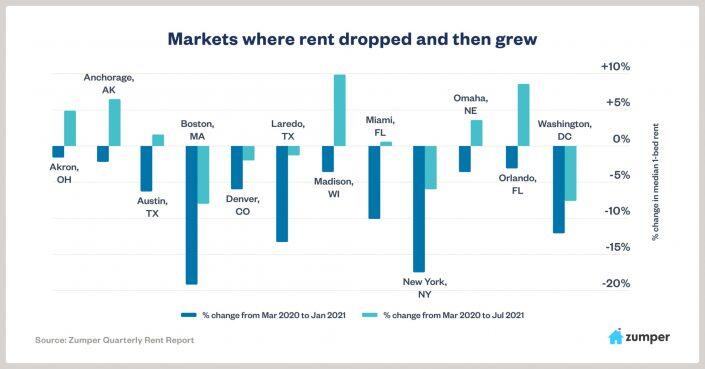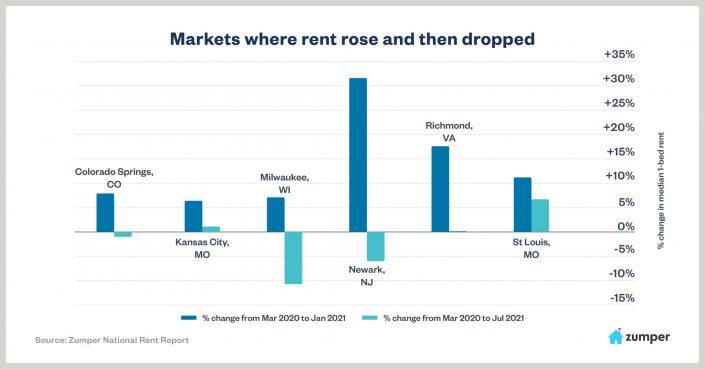 Rental payments improve in February after stimulus payments
Rental payments improve in February after stimulus payments
Trending
Vaccines rerouted the pandemic migration: report
Cultural hubs saw rents snap back; remote work shaped numbers in many markets

Tales of urban-to-suburban flight dominated the first few months of the pandemic as renters ditched cramped apartments for open space. But as cases receded and vaccination counts grew, some cities refilled, though, not all equally.
A survey of rents paid this July compared to January — a gauge of before and after vaccinations became available — showed that prices stayed low in areas where work-from-home was prevalent and rebounded most drastically in cities where renters returned for school or entertainment.
The report, by apartment listing site Zumper, surveyed rents in the nation’s 100 largest cities as a proxy for rebounding renter demand.
In San Francisco, that recovery has yet to manifest. The city posted the steepest drop in one-bedroom rents among the cities surveyed: prices plummeted 23.4 percent from March 2020 to January 2021. And as of July, rents had ticked up less than one percentage point. Bay Area neighbors Oakland and San Jose saw similarly flat rents.
Driving the trend is the ubiquity of remote work, said Jeff Andrews, who authored the Zumper report. Even as vaccinations rose, workers were by and large not called back to the office.
Philadelphia, Seattle, Los Angeles and Buffalo, NY also saw minimal rent growth.
New York City’s comeback, on the other hand, has been widely documented. Even as most companies allowed for remote work, the reopening of things to do drew renters back to the Big Apple. Rents for a one-bedroom jumped 11.5 percentage points to $2,680 in July from $2,350 in January.

Smaller markets with quality-of-life draws saw similar snapbacks. Madison, Wisconsin, a college town considered by some to be the Austin of the Midwest, saw rent jump 9.9 percent in July. Actual Austin saw rents that were down 6.3 percent pre-vaccines rise 1.3 percent above pre-pandemic prices as of last month. And Boston, one of the largest college towns in the country, posted similar rebounds as students flocked back.
Zumper’s Andrews noted that those rising prices are also the result of the hot housing market which has pushed up rents as priced-out potential buyers are forced to sign yet another lease.
“The Boston housing market is one of the most kinetic in the nation at the moment,” he said.
The most dramatic shift in pre-and post-vaccine rents occurred between gateway cities and the city next door.

Newark, for example, saw rents rise over 31 percent from March 2020 through January, as New Yorkers added to the city’s population. As of July 2021, rents had dropped nearly 37 percentage points to settle 6 percent below pre-pandemic figures.
Year-over-year comparisons are the norm for rent patterns, as they account for seasonal dips — like lower rents in the winter when people are less likely to move. But because the pandemic so drastically disrupted norms, Zumper decided to use the cusp of the pandemic as a starting point.
“A lot of the cyclical nature of rent went out the window during the pandemic,” said Andrews. “I really think every report should be using the baseline of March 2020, right now.”
It’s highly possible that the ending of the eviction moratorium, the spread of the Delta variant and the response by state and local governments will impact migration patterns and rents further.
Read more
 Rental payments improve in February after stimulus payments
Rental payments improve in February after stimulus payments




